See also: companion article Maps: Many Varieties and Many Uses
Mapping North Carolina

Mariners and explorers were some of the first Europeans to make maps of what is now North Carolina. A German mapmaker named Theodor De Bry created one of the earliest maps in 1590. He published a map called “Map of Virginia.” It displayed the coast of what is now part of North Carolina. And it included the area where the Roanoke Colony had settled a few years before. In 1590, the region had not received the name "Carolina", or "North Carolina", or even become a colony. The territory was part of Virginia. And at the time, Roanoke Island was one of the known landmarks. If you can locate Roanoke Island on the map (see the image of De Bry's map), you might be surprised that it’s spelled “Roanoac”. The island was named for the Roanoac tribe, native peoples who lived in the area.
By the mid-to late 1600s, maps of North America and the colonies had become more sophisticated. They began to more accurately represent the geography, landforms, and known places. By then, the English referred to the area as "Carolina," since the colony had been established in 1663. Around 1685, three English mapmakers in London, England, created a map called “A New Map of Carolina” (see the image). I included many more details about the region, drawn to a more realistic scale. If you compared that to a map of North Carolina today, you would be able to easily identify many well-known locations such as rivers, a few towns, and the Outer Banks.
Mapmakers have created thousands of more maps of North Carolina for many different purposes. The colony and state changed over time. The General Assembly added new counties. And sometimes county names changed along with their boundaries. With changes came the need for newer and more accurate maps. In 1911, the state added its last two counties, Hoke and Avery. Not long after, mapmakers created new maps showing all 100 counties. Some maps show counties and cities and towns. Others have been drawn to show regions and landforms, roads, railroads, and many other landscape features.


